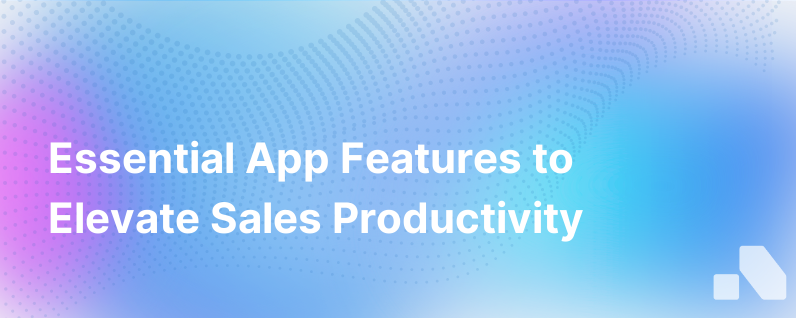Three Requirements For Apps Designed To Increase Sales Productivity
Published on November 5, 2023 by Sawyer Middeleer
With the proliferation of technology in today’s sales environment, the right application can be a determining factor in whether a business soars to new sales heights or struggles to reach its targets. In any B2B sales team, productivity is the holy grail—attracting, nurturing, and converting qualified leads is often contingent on how effectively a sales rep can make use of their time and resources. Thus, the apps they rely on need to be designed to power through inefficiencies and optimize every sales opportunity.
But what elevates a sales productivity app from just another tool in the tech stack to an indispensable ally in the quest for more strategic selling? Here are three non-negotiable requirements that any application promising to increase sales productivity must satisfy.
1. Seamless Integration and Synchronization
Integrating seamlessly into the existing tech ecosystem is arguably the most critical requirement of a sales productivity app. Modern sales teams often use a range of tools including customer relationship management (CRM) systems, email marketing platforms, social media, and numerous other digital tools and technologies to gather insights, communicate with prospects, and close deals.
Sales productivity apps must, therefore, play well with others. They should integrate effortlessly with CRMs like Salesforce and HubSpot to synchronize data across platforms. Real-time data flow is essential, as sales reps cannot afford the downtime that comes from manual data entry or inconsistent information across systems. By ensuring that every piece of customer data is automatically updated and accessible throughout the entire sales stack, productivity apps remove friction and minimize the risk of error.
Furthermore, sales apps should offer API access to foster a smooth exchange of data, thus facilitating a cohesive, unified sales process. This kind of deep integration means that the app becomes part of a holistic solution, rather than a standalone platform that adds to the noise and clutter.
2. Intuitive User Experience and Mobile Optimization
Complexity is the enemy of productivity. For sales apps to truly increase productivity, they must be intuitive and require minimal training to use. The app’s user interface (UI) should be clean and user-friendly; complex functions should be broken down into simple steps that sales reps can execute quickly.
Streamlining the user experience (UX) includes features like customizable dashboards that highlight key sales metrics, predictive search functionality, and one-click operations for common tasks. When a rep is in the heat of selling, the last thing they need is to navigate a convoluted interface that distracts them from their primary goal—making sales.
Apps must also be optimized for mobile use, a non-negotiable requirement as sales teams are increasingly mobile and often need to access information and tools on the go. An app designed to enhance productivity should empower them to do everything from their smartphones or tablets efficiently. This ranges from entering data into the CRM, accessing sales materials, to communicating with prospects and customers.
3. Data-Driven Insights and Actionable Intelligence
An app will only be as good as the intelligence it provides. In the world of sales, every minute counts, and reps need to focus their time on the leads and activities that are most likely to convert and yield the highest returns. This means the app should leverage artificial intelligence (AI) and machine learning algorithms to process vast volumes of data and deliver actionable insights.
To optimize sales productivity, an app should offer capabilities such as:
- Real-time Analytics: Offering up-to-the-minute data analysis that informs decision-making in real-time.
- AI-powered Lead Scoring: Using intelligence to prioritize leads based on their propensity to buy, so sales reps can focus their attention where it's most impactful.
- Predictive Forecasting: Utilizing historical data to project future sales, helping leaders manage resources and strategies more effectively.
- Personalized Content and Recommendations: Crafting tailored messaging and sales tactics for individual prospects based on their behaviors and preferences.
While data is undoubtedly a valuable asset, it can also be overwhelming. Therefore, a productivity app must not only collect and analyze data but also present it in a way that is easily digestible and translated into actionable steps. This helps sales reps to make informed decisions without sifting through mountains of information.
Final Thoughts
Being equipped with an app that harmoniously integrates into a broader sales ecosystem, offers an effortless user experience, and delivers actionable insights, is akin to giving sales reps a crystal ball and a magic wand. With these tools—a clear view of the opportunities ahead and the ability to actualize their potential—productivity soars.
In the end, sales productivity apps must do more than merely automate tasks. They must be thoughtfully designed to integrate seamlessly and reduce friction, provide a clean and responsive user experience while on the move, and finally, they should employ robust data analytics to empower sales teams with actionable intelligence gathered in real-time.
For contemporary sales teams, the right app—one that embodies these three core requirements—isn't just a productivity booster. It's a transformative force that reshapes the sales landscape by injecting efficiency, insight, and agility into every interaction. This is where platforms like Aomni make a meaningful impact; providing sales professionals with an intuitive, intelligent, and integrated application that lays down the digital tracks for a high-speed journey towards exceeding sales goals.